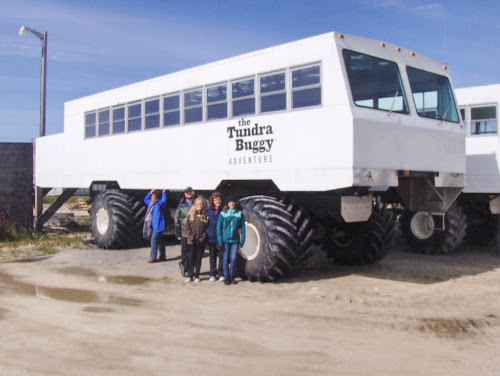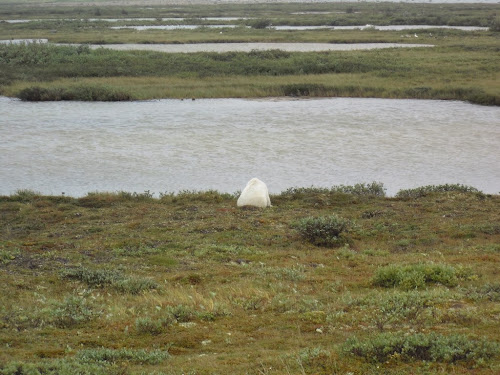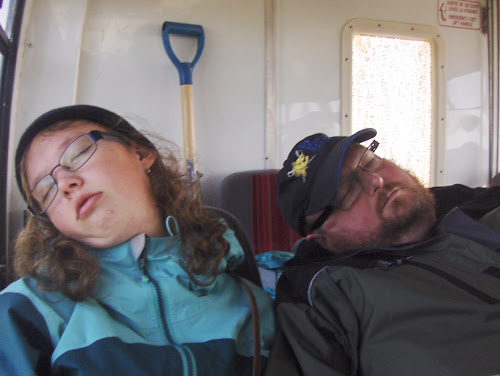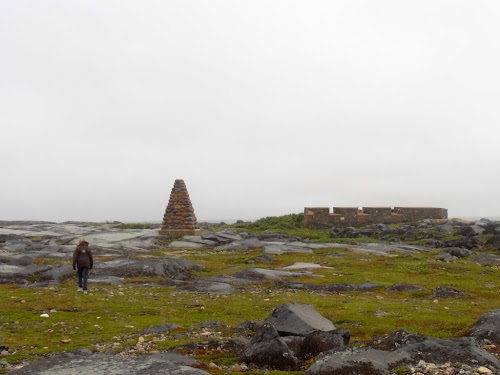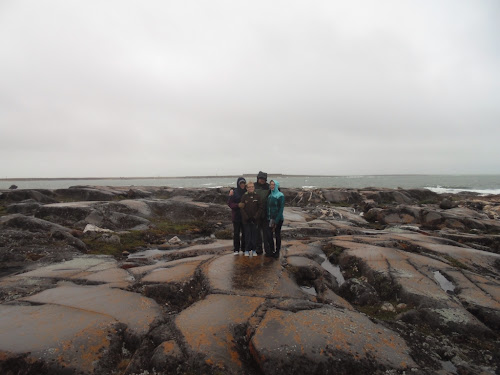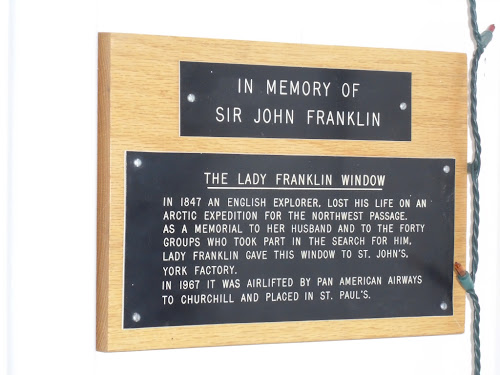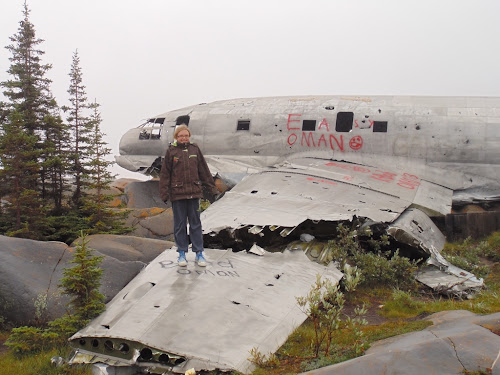Parks Canada maintains a small dock and shelter, as well as some toilets about 200 yards south of the fort proper. Most people arrange their tour with the Parks Canada staff at the train station back in Churchill, and get boated across accordingly. With Parker having his own boat, we pulled up on the gravel beach, and our guide, Heather, told us we could settle up back in town, since they didn't have any receipts or change on this side.
Heather was one of two Parks staff who accompanied us on our tour, and was very knowledgeable about the fort, it's history and it's restoration. The other was Brian, our designated bear monitor; since the fort is located on something called Polar Bear Point, this seemed like an excellent use of resources.
Brian had a utilitarian looking 12 gauge pump-action shotgun slung over his shoulder, which prompted me to inquire of Parker as to why this made more sense than, say, a semi-automatic rifle. (Or perhaps a railgun.) I don't have much practical experience with guns, but the limited range of a shotgun made it a curious choice to me, despite the stopping power I know it to have at close quarters. Parker patiently explained to me that they are not loaded with buckshot, but with a solid slug, like an enormous bullet. He said they carry something in the range of 500-700 foot-pounds of force against a target, which even a polar bear would find hard to shrug off. That made sense, but honestly, the concept had validity to me as soon as you replaced a bunch of smaller projectiles with a single, 18mm bullet...
At any rate, we didn't expect to see any bears inside the fort, and that was what we had come to see. Heather explained that the stone, star-shaped fort took over 40 years to build in the 18th century, and how it was used as a headquarters and trading post by the Hudson's Bay Company.
Once inside, you can see how a central courtyard had once contained two, two-story blockhouses. The bottom story was made of stone, the top of wood and other local materials, but only the stone remains. A Freemason's symbol remains engraved on one of the walls, a testimonial to the lasting power of stone.
Imagining life, here,so close to the bay, in the dead of winter, is difficult for us soft 21st century Canadians. Small wonder that a man was hanged for stealing a goose intended for Christmas dinner.
Considering how remote this fort was back in the day, and how thick the walls, plus the added firepower of the Cape Merry Battery across the river, you could see how residing here might lead one to feel lonely, but relatively safe. This turned out to be anything but true, and the Prince of Wales Fort was surrendered without a shot in 1782.
3 ships approached the fort that year, flying the Royal Jack, the same flag that waved above the fort, but Samuel Hearne, the governor, had joined the Royal Navy as a midshipman at the age of 12 (in fact, he may have been the inspiration for Coleridge's Rime of the Ancient Mariner), and recognized French warships when he saw them. The two frigates were bad enough, but the largest vessel, the Sceptre, under command of the Comte La Pérouse, boasted more guns at 74 than the fort and battery combined. Hearne exited the fort with a white flag and probably saved the lives of the 38 civilians under his command.
The French set to destroying the fort, and although the British and HBC returned the following year, it never returned to the same prominence, as the fur trade had already began to wane, the hunters and trappers having moved on to other posts. He returned to England in 1787, writing his A Journey from Prince of Wales's Fort in Hudson's Bay to the Northern Ocean, which wouldn't be published until three years after his death in 1792, at age 47, my age as I write this.
What lessons does Fort Prince of Wales teach to us, a quarter-millennium later? That Europeans hell bent on exploration can bring themselves to live just about anywhere on this planet? That even thick walls and good positioning are no match for determination and superior numbers? That progress is almost always linked to commerce, and the company we now know best as an American-owned department store did the lion's share of the work? That fate is fickle, and the rise of our nation is due to nothing quite so much as the fashion in 18th century men's hats is testimony to that? It is tough to say.
While at the fort though, Audrey heard Brian's radio go off, asking if he had seen the bear by the beach. She went to the west side of the fort and peered through the crenellations and sure enough, a now-familiar white shape was loping lazily along the shore perhaps 80-100 yards distant. He disappeared behind a hill before I could snap a picture, but given how close we had gotten to two the day before, I hardly felt disappointed. It did underscore the constant presence of these beasts, and the vigilance required to live here.
On our way back to the boat, Brian called out to Belinda. "I hate to interrupt, but what's the special at the Tundra Inn tonight?"
Belinda smiled. "Prime rib, sushi, live music, and a contortionist!"
The bear monitor's face lit up with a grin. "I'm all over that!"
UPDATED: I really miss these animated vignettes, so here is the one about the fort.



























